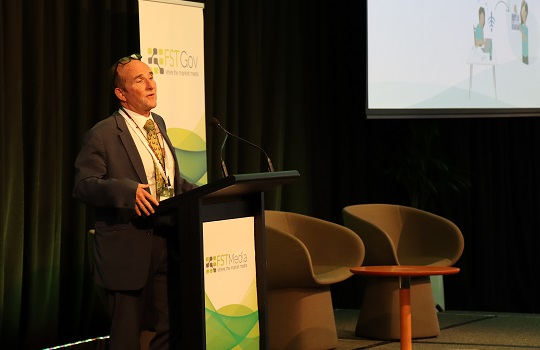
In its efforts to bridge the digital divide, public libraries have stood at the front line of the WA Government’s push to upskill and empower digitally excluded communities. Yet, many of the state’s libraries are still crying out for basic resources and connectivity to support these digital inclusion initiatives, according to Dr John Dixon, director of ICT policy and governance at WA’s Office of Digital Government.
Noting community feedback from a round of recent public consultations to address the state’s digital divide (resulting in “at least 75,000 interactions”, he said), Dixon, speaking at the recent FST Government WA event, said there was widespread recognition of the enormous value that public libraries bring to supporting the state’s digital inclusion and upskilling initiatives.
“And we heard that from everywhere, from industry as well as the community sector,” he said.
“Libraries have the [staff] and the space to help people with digital inclusion.”
This also includes vital training to enable communities of all stripes to engage digitally with the Government, including through its one-stop-shop Service WA app – an essential hub for citizens to access government support services, particularly where on-the-ground services are lacking.
“They need help with technology, and [libraries have] passionate people in the community to help others,” Dixon said.
However, the reverse situation may also be true for many of these resource-starved community touchpoints, he acknowledged. While libraries may have been fortunate to snag a high-quality broadband connection (particularly when adjacent to another government office), according to Dixon, their dedicated staff may lack the resources, time (with many operating only part-time), and apposite skills to deliver on the Government’s goals.
Digital inclusion forms one of the core pillars of the WA Government’s Digital Strategy Roadmap, with the state currently developing its Digital Inclusion Blueprint following a public consultation, back in 2020, of its draft Blueprint.
The state’s digital inclusion program sets an “ambitious agenda”, Dixon said, operating under a core tenet that “all West Australians should be able to easily access and use digital technologies”.
It comes with a recognition that a significant portion of WA’s population remains “digitally disconnected” – often as a result of considerable socioeconomic disadvantage, Dixon said.
The WA Government, commendably, appears to have reaped tangible gains over the last two years in advancing its digital inclusion goals. In its annual ranking of digital inclusion, the Australian Digital Inclusion Index (ADII) ranked WA equal second, alongside Victoria, as Australia’s most digital inclusive state or territory.
However, the inclusion gap between WA’s regional and metro areas remains stark. For instance, the ADII found an 18-point difference between the Gingin area (with a score of 61), on Perth’s fringe, and the Perth metro area (79), despite being less than 70kms from each other.
According to the ADII’s most recent rating, more than one in 10 Australians remain “highly excluded” from the digital economy.
This cohort often faces considerable socio-economic disadvantages, most likely to: have not completed a secondary education (38 per cent); fall in the lowest income quintile (31 per cent); live in a single person household (26 per cent); have a disability (23 per cent); currently be unemployed (21 per cent); not be in the labour force (22 per cent).
WA’s digital exclusion figures parallel the national average, with 11.6 per cent of WA households having no access to the internet, according to Dixon, and around one in four of the state’s lowest income earners not going online at all.
A key learning from the state’s consultations was a recognition that the Government “cannot rely on a single entity” to deliver on its digital inclusion goals. Community input, Dixon stressed, is indispensable.
“It has to be a partnership approach. And that partnership approach… does require some central coordination from the Government. But, more importantly, you have to bring all players along.”
This not only means establishing strong cross-agency partnership frameworks, but also deep engagements with community services organisations, including various advocacy groups. Dixon, for instance, singled out the work done between the State Government and the Aboriginal Advisory Council of Western Australia.
“We learnt to understand that those [advocacy] groups are the ones who have the most knowledge around and engagement with [those] experiencing digital disadvantage.”
“Whatever we do in this space, it’s not one entity and it’s not just a single government doing it.”
No need to reinvent the wheel
For Dixon, with a preponderance of relevant and high-quality digital inclusion and upskilling initiatives happening across the country, there is little point in reinventing the wheel – stakeholders, he said, should leverage successful programs already in the works.
Consultation feedback revealed a “truckload of duplication” in digital inclusion schemes, he said.
“We realised [during our consultations] that we’re not starting from a blank page. There’s already a range of fantastic initiatives nationally at all tiers of government that are working progressively on how we address and improve digital inclusion outcomes for people.”
He cited an NBN Co initiative providing cybersecurity retraining and upskilling opportunities to coal mining communities.
“They have ready-made training programs that could be applicable for broader use across the public and state library network,” he said.
While this does not necessarily require the same company to deliver that training, there should, Dixon stressed, be ways to share these resources and make them available more broadly, particularly at the local level. This is also a far more cost-effective solution for governments than building these programs from scratch.
“With better coordination and a better understanding of what’s going on, we can help deliver more improved outcomes without necessarily assuming that it’s all got to cost something.”
Above all, Dixon stressed, the path to digital inclusion cannot be trod by government agencies alone, but must be in lock step with local communities, co-designing solutions that can best meet their unique needs.
“There’s no point having a good intention with people going off and designing something to do with those most vulnerable people.”
“Digital inclusion is something that has to be done with the community and not to the community.”





